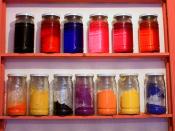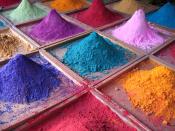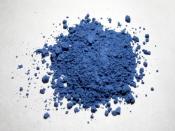OBJECTIVES: The objective of this experiment was to extract plant leaf pigments and determining them by using the Rf values obtained from the paper chromatography technique. The hypothesis of the experiment was that all of the five listed pigments would be present in the extracted plant leaf according to the Rf values.
PROCEDURE/APPARATUS: The equipments used were a 18 x 150 mm test tube with stopper, graduated cylinders, Erlenmeyer flask, mortar and pestle, metric ruler, tall jar, acetone, tiny test tube, small brown bottle, petroleum ether, plant leaf, dried parsley flakes, water, glass petri dish, stapler, sand, spatula, pipette, capillary tube, Whatman filter paper, a 50 ml chromatography solvent, and goggles (to be worn at all times). The steps to performing the experiment were:
1. Pour 50 ml of chromatography solvent into the tall jar and cover it with half of the petri dish.
2. Take ý teaspoon of dried parsley flakes and ü teaspoon of sand in the mortar.
Tear a plant leaf into small pieces, and place it in the mortar along with the other materials and grind it for 10 seconds. After that, place the ground materials in the test tube and add 5 ml of acetone.
3. Shake for 10 seconds, and after 10 minutes add 5 ml of water. Then, add 3 ml of petroleum ether and shake for 5 seconds. The pigment will eventually be found on the upper layer; remove it with a pipette and place it in a small test tube in the brown bottle. Note: dispose of the remaining materials.
4. Draw a faint pencil line on a filter paper, 1.5 cm from one edge. Then, using a capillary tube, make 6 or 7 dots on the pencil line (repeat the step till the dots are dark enough).
5. Form...


